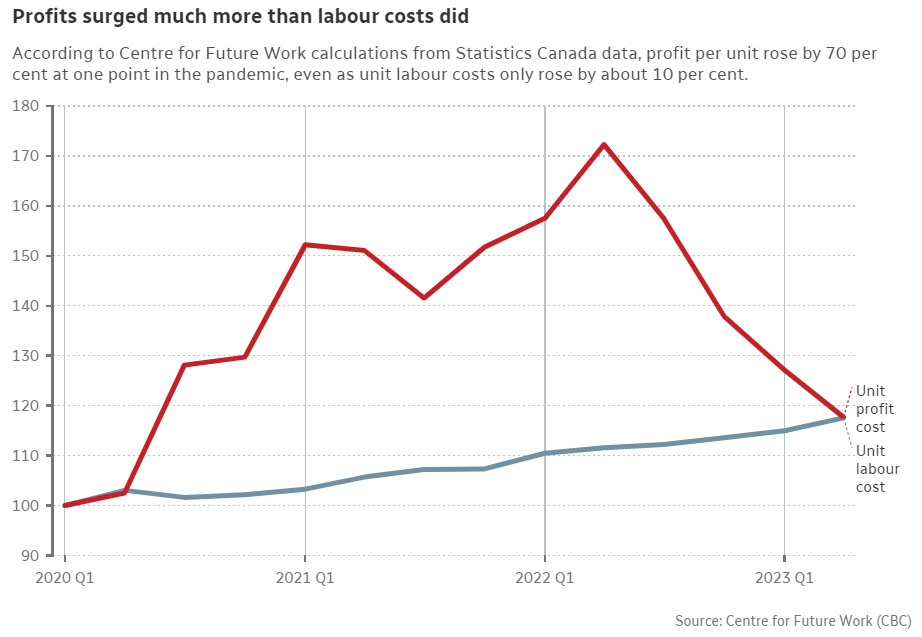High inflation has given corporations cover to raise their prices, and central banks are now taking notice,
Corporations are a lot more willing than usual to raise their prices lately, and it’s putting more of the burden of high inflation on consumers.
That may not come as much of a surprise to anyone who has browsed a grocery aisle, kicked the tires at a car dealership or filled up a gas tank of late, but even the Bank of Canada is starting to take notice of the trend, as the central bank continues its battle to wrestle inflation into submission.
Speaking to a parliamentary committee in Ottawa this week, the bank’s governor, Tiff Macklem, told lawmakers that the bank has noticed a troubling new trend coming out of the corporate sector.
For much of the past few decades, any time businesses have seen a jump in their input costs — the amount they pay for things like raw materials, energy and even workers — “they were pretty cautious about passing on [that cost into] the prices they charged for goods and services,” Macklem said.
Their reasoning was simple: they were afraid of losing customers.
Companies more willing to raise prices lately, says Bank of Canada governor
Last week, Bank of Canada head Tiff Macklem says companies are typically reluctant to raise their prices for fear of losing customers, but high inflation has made them much more willing to do so lately, without worrying that consumers will tap out.
But in this bout of high inflation, the bank has noticed that corporations aren’t nearly as worried about doing that as they typically are.
“When input prices have gone up … those are getting passed through much more quickly to final goods prices. So households are bearing the full inflationary impact much more: that’s what we can see pretty clearly in the data.”
When asked how much of Canada’s current inflationary problem can be blamed on price hikes above and beyond companies’ cost increases, Macklem said, “I don’t think we can put a number on it,” but other central bankers have been far more willing.

In a speech this summer, Christine Lagarde cited data from the European Central Bank she leads showing that for the 20 years leading up to 2022, corporate profits were responsible for about one-third of inflation.
Last year, however, that ratio jumped to two-thirds, which means that despite legitimate increases in their cost of doing business, their take-home share of every consumer dollar effectively doubled.
“Firms cannot continue to display the pricing behaviour we have recently seen,” she said.
‘Profit-led inflation’
Paul Donovan, a London-based economist with Swiss bank UBS, says the scenario described above is what’s known as “profit-led inflation” and he’s been waving red flags about it for most of the past year.
While it has exposed itself to varying degrees in various places around the world, the one condition it requires is a strong narrative: consumers have to believe en masse that price increases are justified, or they won’t accept them.
“Profit-led inflation works until it does not and the point where consumers start to rebel against profit-led price increases disguised as other factors tends to be a tipping point with a sharp turn,” he told CBC News in an email.
While he stresses he isn’t familiar with the situation in Canada, he says in Europe there is ample evidence to show that consumers have reached that tipping point of saying “enough’s enough” and the best place to observe that is very familiar to Canadians: in the grocery aisle.

How these Canadians are dealing with the high cost of living
CBC News spoke to several people in downtown Toronto about the financial challenges they’re contending with, including housing, food and child care, and what they’re doing to keep expenses down.
Last month, the British Retail Consortium noted that “fierce competition between retailers” caused U.K. food prices to decline on a monthly basis for the first time since 2021. Donovan says that’s no accident, as the major chains have started offering deep discounts to their most loyal customers after the latter group started to abandon them
“In the past few months there have been aggressive price discounts — but which apply to people who hold loyalty cards,” he said. “Consumers in the U.K. have shown themselves less willing to believe the narrative of why prices were rising, and supermarkets are eager not to alienate customers and so seek to shore up loyalty through the privileged discount scheme.”
Data from the U.S. shows evidence that price increases may have gotten ahead of themselves, too. A report by the Federal Reserve Bank of Kansas City calculated that markups increased by 3.4 per cent in the U.S. in 2021 — enough to make them responsible for as much as half the increase in the U.S. inflation rate that year.
Jim Stanford, an economist and director at the Centre for Future Work, says its refreshing to see central bankers start to acknowledge that corporate profits have played a disproportionate role in inflation, because for too long Canada’s economic discourse has been trying to put the blame on anything but that.
Burden rests on consumers
“Tiff Macklem has been talking about so-called overheated labour markets nonstop for the last two years,” he told CBC News in an interview. “And now I think they’re they’re finally recognizing that is not the story — or certainly not the whole story.”
Advice for consumers for much of the past year has boiled down to either trying to cut back on expenses, or increasing income, but Stanford says it’s misleading to put the onus on consumers to solve inflation, since they’re the ones bearing the disproportionate burden of it.
“There is evidence that consumers are getting tapped out,” he said, noting that grocery store sales and overall retail sales are now declining in volume terms for the past three months at least.
“I’m reluctant to say that consumers just need to get better at shopping around. I’ve heard that advice from a dozen people [but] I think it’s unreasonable to expect that somehow consumers have to solve the problem by becoming bargain hunters and spending half their week looking at grocery store leaflets.”
He cites data from Statistics Canada showing that at one point last year, the cost of a unit of labour had increased by a little more than 10 per cent since the start of the pandemic. The per-unit profit, meanwhile, was up by more than 70 per cent over that same time frame.
But the good news, Stanford says, is that trend is starting to reverse.
“The last two quarters in Canada have seen a partial but significant return of profitability back toward normal levels,” he said.
“This actually reinforces the story that profits had a lot to do with that outburst of post-pandemic inflation because on the way up, profits and prices went closely together and on the way down they’re coming down together as well.”
ABOUT THE AUTHOR

Senior Business Writer
Pete Evans is the senior business writer for CBCNews.ca. Prior to coming to the CBC, his work has appeared in the Globe & Mail, the Financial Post, the Toronto Star, and Canadian Business Magazine. Twitter: @p_evans Email: pete.evans@cbc.ca
*****
Credit belongs to : www.cbc.ca
 Atin Ito First Filipino Community Newspaper in Ontario
Atin Ito First Filipino Community Newspaper in Ontario





